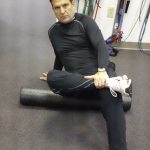How to get in shape for volleyball!
Because the pattern of volleyball movements is so unpredictable, it saps more of your body energy when you move. So you can’t afford to waste additional energy with inefficient movement patterns. It is critical that you move efficiently, especially through your hips, torso, and shoulders, also known as your “Pillar”. Exercises like the plank, plank with arm movement and gluteal bridge marching will help solidify this area and prepare your torso for the intense, rotational demands of volleyball. In addition to developing leg strength and power, building a solid foundation of pillar strength will give you a platform to leap higher, swing harder and cover the court faster.
Foam roller technique
Foam rolling technique uses deep compression to help roll out muscle adhesions, over time. Think of your muscle as a shoelace. It has a certain length to it. If you pull on both ends of the shoestring, the knot will become tighter. You need to work the knot out and restore the original length of the shoelace. The same goes for your muscles. By working out those knots in the muscle, which often are due to repetitive activity, you will be able to restore the muscle to its original length and function. This technique is very efficient and should coincide with your daily stretching activities.
How to loosen up a tight ilio-band
Have you ever felt tightness along the outside of your thigh? That is your iliotibial band, a long tissue that attaches at your knee into a muscle called the tensor fascia latae (TFL) on your hip. When the TFL becomes overly stressed, it pulls on the iliotibial band. Many runners who complain of iliotibial tightness will continue to stretch the iliotibial band but fail to address the real problem – weak gluteal muscles. Try gliding your iliotibial band, TFL, quadriceps muscles and hamstrings over a foam roller to loosen them up.
Then work on strengthening your gluteal muscles with exercises like bridges and band X walks.
How do I improve hamstring flexibility?
This is a question I receive on a daily basis. Muscles often tighten up because your body is trying to create stability where it is lacking. For instance, you might think your hamstrings are tight, but the underlying issue could be an unstable core. So if you simply improve the flexibility of the tight muscle, you may actually be removing your body’s point of stability. As a result, your body can become more unstable, increasing your risk of injury. If you’ve been stretching your hamstring for years, and they are still tight, it is not a hamstring issue. Try these exercises instead.
- Lateral Squat
- X Walk
- Drop Lunges
ACL injury prevention
ACL injuries are becoming ridiculously common among athletes from the junior high/high school levels on through the professional levels of all sports. My personal thoughts on this issue are that they are a result of the poor training programs most of these kids go through.
The act of jumping and leaving the floor is not so much the problem. But what goes up, must come down, and it’s not always pretty when it does. Landing incorrectly, with the knees in an abnormal formation, is a major cause of ACL injuries.
Landing efficiently involves all the following: Landing on the balls of the feet; knees aligned with the mid to outer foot; hips are back absorbing force; slight forward lean of the trunk with the back flat. Basically it is a good squat position!
So when addressing ACL prevention, start with squat progression exercises and progress into landing progression exercises with single and double legs.


